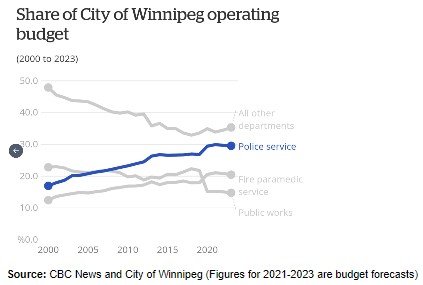Loney To Address Homelessness
People living in bus shelters and along waterways
to be housed within a year
Released June 27, 2022
WINNIPEG, Manitoba - Mayoral candidate Shaun Loney says when elected Mayor in October, he will move quickly to implement an innovative plan to address homelessness in Winnipeg that will not require additional resources and will also free up emergency responders to focus on the work they were trained to do.
“We’ve been looking at homelessness the wrong way,” said Loney, an entrepreneur and economist who is recognized nationally for his work creating jobs in Winnipeg’s inner city. “The opportunity in front of us is to address ballooning emergency services spending and homelessness at the same time.”
Loney laid out his plan at the corner of Higgins Avenue and Main Street. The plan will result in people who are living in bus shelters and along riverbanks being housed within a year, with people living downtown to be housed in a second phase.
Al Weibe, from Canadian Lived Experience Leadership Network, who was homeless in Winnipeg for years said, “Homelessness is complex. It is often the result of a confluence of trauma, addiction and mental health issues. Loney’s approach lets us meet people where they are at with what they need. That’s why it will work.”
Loney explained that when someone who is homeless is in crisis it initiates an expensive domino effect. The typical pattern begins with a 911 call which triggers a police car with two officers, a fire truck and then an ambulance trip to an emergency ward where EMS and or police often sit for hours waiting for the individual to receive medical treatment. Interactions with courts and jails are also common.
Research shows that someone living on the street can trigger 100 or more interactions with emergency services in a year, added Loney.
It’s an unending cycle because the reason the person was in crisis in the first place - addictions and mental health issues - aren’t addressed.
“For the majority of our sisters and brothers on the streets, the costs incurred by the city responding to the same people over and over again far exceed the costs of providing the supports that would prevent the crisis from happening in the first place,” added Mitch Bourbonniere who both works with people on the street and teaches in the Urban and Inner City Studies department at the University of Winnipeg.
“It’s hard to imagine a less effective approach than what we are doing now,” said Bourbonniere.
Loney adds, “Fortunately, there are a number of paths that are both more humane and more cost effective such as supportive housing, addictions treatment and mental health services.”
“Our plan gives emergency services a new public safety tool that modernizes their relationship with nonprofits. This is how we get the kind, compassionate city we all want while protecting the public purse,” said Loney.
THE LONEY PLAN
1. Emergency service agencies identify people they see on a regular basis.
2. For the very first time, each emergency service provider will determine the actual value of the staff time used annually to respond to this group; and
3. Emergency service providers agree to compensate nonprofits for the value of avoided workload achieved.
“Our straightforward plan gives nonprofits the revenue streams to provide long-needed customized, holistic supports,” said Loney.
Loney, an economist and entrepreneur, has created hundreds of jobs for Winnipeggers who would otherwise be on welfare, in jail or on the street.
“People ask me how we will get the province to work with us on this issue,” said Loney. “I will engage the Premier directly and invite her government to get better results for taxpayer money. Everyone needs to understand our current approach is far more expensive than what we are doing now. We need to modernize our approach to public safety and allow our agencies to get the best impact for money.”
Retired Winnipeg Police Service Executive member Gord Friesen joined Loney.
“This plan is something that I think the WPS will see the value in. The service isn’t being asked to pay for supportive housing, they are being offered a new cost-effective public safety tool that frees them up to focus on crime,” Friesen said.
Charles Loewen, co-founder of End Homelessness Winnipeg said, “Loney’s experience as a senior civil servant and social entrepreneur meld to allow for this innovative solution.”
“We can address homelessness if people currently unsheltered are treated with dignity and given better options,” said Kelly Holmes, Executive Director of Resource Assistance for Youth.
The innovative approach – detailed in a report co-authored by Loney called “The Winnipeg Model” - has garnered support across Canada including from national non-profits such as A Way Home, The Homelessness Observatory and Raising the Roof. Loney’s approach was also published in a major report released by the Canada West Foundation in April 2022.
“Loney’s approach goes beyond politics,” said Marc Soberano of Raising the Roof, in Toronto.
“I’d like to see every candidate for Mayor in every city endorse this.”
Loney’s campaign released data showing virtually all growth in spending to operate the City of Winnipeg for almost two decades has gone to emergency services (see chart in Backgrounder below).
Backgrounder
1.
Data derived from City Of Winnipeg - Community Trends And Performance Report - June 2020 pg 44.
2. The proportion of spending on emergency services (police, fire and paramedic) has increased significantly over the past two decades while the proportion of spending on public works and all other civic departments has shrunk.
Source: CBC News and City of Winnipeg (Figures for 2021-2023 are budget forecasts)
3. Winnipeg Fire Paramedic Service responded to 1,770 calls at Winnipeg Transit bus shelters last year. CBC Feb 2022
4. Police dispatches increased from 154,097 in 2008 to 241,795 in 2020, a 57 percent increase in 12 years. At the same time, the Winnipeg Police Service budget increased from $170.9 million in 2008 to $319.7 (2022 budget), an 87 percent jump in 14 years. About 53 percent of Winnipeg Police Service dispatches are not related to emergencies. Many Canadian police chiefs have stated that 80 percent of their workload is not criminal in nature.
5. The At Home/Chez Soi study tracked people who were homeless and received supportive housing over a four-year period. Data from the study showed that a known group of people experiencing homelessness can interact with emergency services 200 or more times per person per year.
6. “We would propose that governments extend procurement - a tool well known to them - to enable this comparison and free them up to select the option that’s of best value to the taxpayer. When we do, we will have connected what we have with what we need. This model is highly applicable to a wide variety of issues, including homelessness in Winnipeg.”
The Winnipeg Model, Encompass Co-op
7. “Through the use of procurement to engage non-profits, governments can shift from crises response and management to ending social problems”.
Financing Social Solutions through Outcomes Procurement - Canada West Foundation


